Main menu
Common skin conditions

NEWS
Join DermNet PRO
Read more
Quick links
Piebaldism — extra information
Piebaldism
Author: Vanessa Ngan, Staff Writer, 2005. DermNet Update August 2021
Introduction Demographics Causes Clinical features Complications Diagnosis Differential diagnoses Treatment Outcome
What is piebaldism?
Piebaldism is a rare inherited disorder of pigmentation characterised by patchy leukoderma (white skin) and white hair (poliosis) present at birth.
The name piebaldism is derived from a combination of the “pie” as in the magpie (a bird of black and white plumage) and the “bald” of the bald eagle (the US national bird that has a white feathered head). Hence the major characteristic of piebaldism is a white forelock (a patch of white hair directly above the forehead).
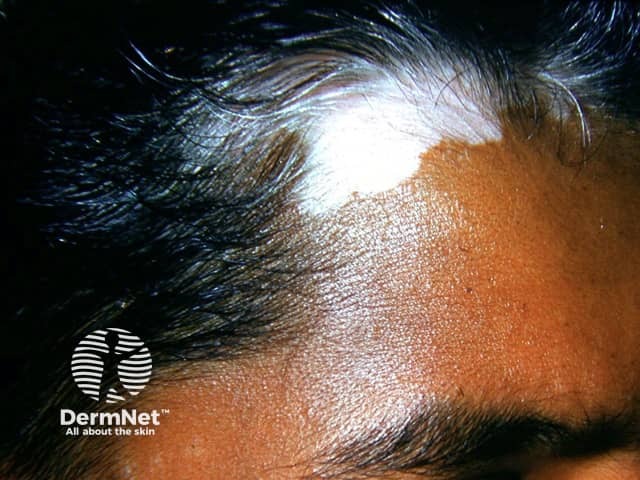
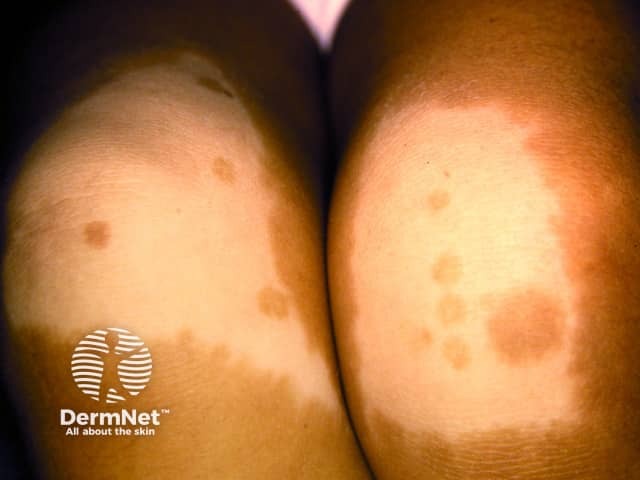
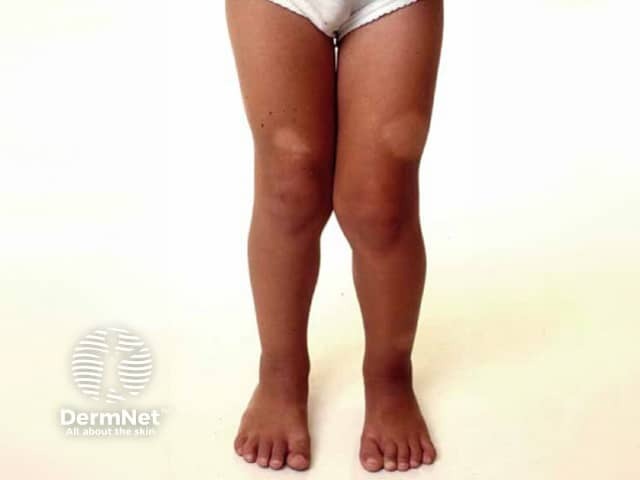
Who gets piebaldism?
Piebaldism is an autosomal dominant genetic condition, so each child of an affected parent has a 50% chance of inheriting the disorder.
What is the cause of piebaldism?
Piebaldism is a neurocristopathy caused by mutations of the KIT proto-oncogene on chromosome 4 account for75% of cases; over 45 different point mutations, deletions, nucleotide splice mutations, and insertions of the KIT gene have been identified. The KIT gene mutation causes aberrant migration of melanoblasts from the neural crest to the skin in the embryo resulting in patches of skin lacking melanocytes. The severity of the condition correlates with the specific mutation within the KIT gene.
What are the clinical features of piebaldism?
- White forelock in 80-90% of those affected (poliosis)
- Leukoderma (white patch due to absence of melanocytes) of the central portion of the forehead
- Eyebrow and eyelash hair may also be affected, either continuously or discontinuously with the forelock
- White patches of skin may also be seen on the face (particularly the chin), trunk and limbs; hands and feet are not usually affected
- Often a narrow border of hyperpigmented skin surrounds the white unpigmented patches
- Sometimes islands of normal or hyperpigmented skin occur within the white patches
- Café-au-lait macules and flexural freckling may develop
The mild form may present with only small patches of leukoderma, whereas in more severe forms have the white forelock and larger white patches over the trunk and limbs.
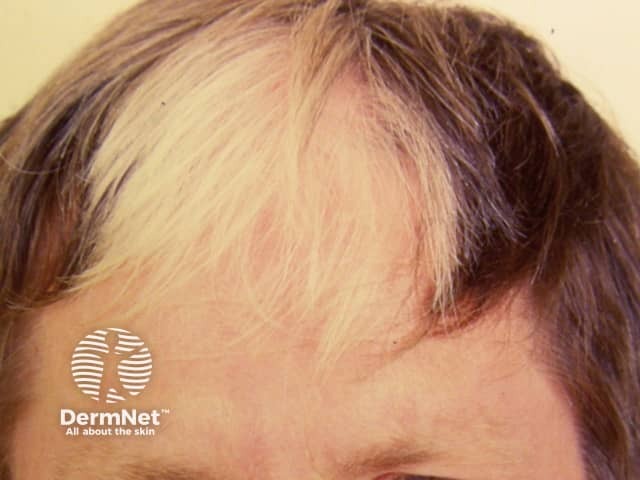
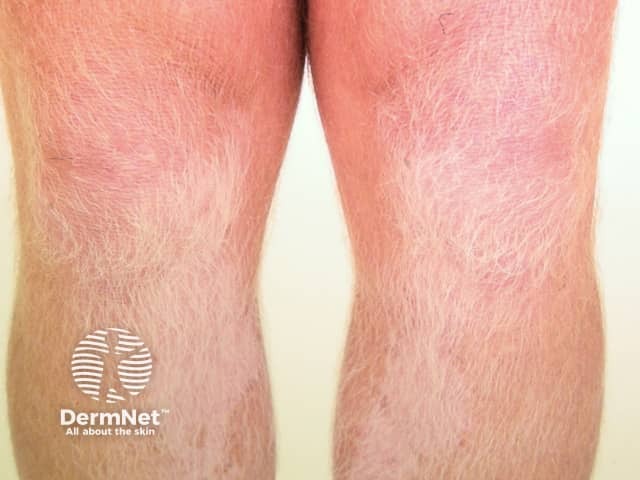
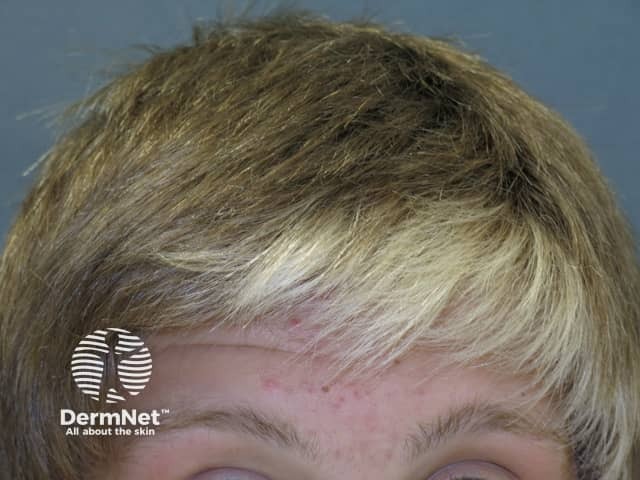
What are the complications of piebaldism?
- Psychosocial effects
- Sunburn of the white skin patches
- Skin cancers developing in the white patches
How is piebaldism diagnosed?
Piebaldism will be suspected clinically at birth or soon after.
Skin biopsy from the leukoderma in patients with piebaldism demonstrates complete lack of melanocytes and melanin pigment.
Genetic testing on peripheral blood can confirm the diagnosis.
What is the differential diagnosis of piebaldism?
- Vitiligo: is an acquired leukoderma and configuration and distribution of lesions is quite different
- Waardenburg syndrome: includes deafness and the distance between the eyes is greater than normal
- Achromic naevus: normal number of melanocytes but impaired melanosome transfer
What is the treatment for piebaldism?
Patients must be educated about the use of sunscreens, sun protective measures, and sun avoidance during peak hours of UV exposure, and self skin examination to detect skin cancer.
Patients who are self-conscious about their appearance may benefit from the following treatments:
- Dermabrasion of areas of depigmentation followed by the application of melanocyte-enriched cell suspensions
- Melanocyte transplant by shaving off the top layer of skin (epidermis) and replacing it by a shave of skin from a pigmented site
- Suction epidermal grafting or full-thickness punch grafts
- A combination of these methods may be required and can be augmented by the addition of UV light therapy
Cosmetic camouflage techniques can cover the pigment changes of hair and skin.
What is the outcome for piebaldism?
Piebaldism is present at birth and the pigment changes usually remain unchanged throughout life. Pigmented dots and macules may develop at the margins or within the patches of leukoderma. The leukoderma may be progressive in rare cases.
Bibliography
- Akarsu S, İlknur T, Avcı C, Fetil E. Piebaldism associated with café-au-lait macules and intertriginous freckling: a case report and review of the literature. Ann Dermatol. 2019;31(5):567–70. doi:10.5021/ad.2019.31.5.567. Journal
- Hamadah I, Chisti M, Haider M, et al. A novel KIT mutation in a family with expanded syndrome of piebaldism. JAAD Case Rep. 2019;5(7):627–31. doi:10.1016/j.jdcr.2019.01.021. PubMed Central
- Oiso N, Fukai K, Kawada A, Suzuki T. Piebaldism. J Dermatol. 2013;40(5):330–5. doi:10.1111/j.1346-8138.2012.01583.x. Journal
- Richards KA, Fukai K, Oiso N, Paller AS. A novel KIT mutation results in piebaldism with progressive depigmentation. J Am Acad Dermatol. 2001;44(2):288–92. doi:10.1067/mjd.2001.112221. PubMed
On DermNet
Other websites
- Waardenburg Syndrome Type I — GeneReviews
- Piebaldism — Medscape Reference
- Piebald trait #172800 OMIM — Online Mendelian Inheritance in Man
